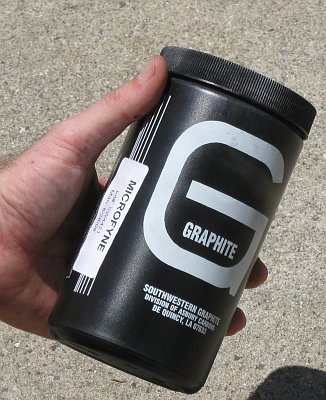
Note 2: When you say "paraffin," I think the Brits think of kerosene. The paraffin I use is from the little squatty votive candles. These don't have the stearic-acid hardener that the tall, slender candles use. (I also found from experience that the Gulfwax paraffin wax you get in the supermarket for canning is not good.)
Note 3: Someone asked about using molybdenum disulfide (MoS2). I have no experience with it, and no real knowledge of it; but as long as it's in powder form, I wouldn't have any objection. The big enemy for bike chains is sand though, so you definitely don't want any liquid lube that keeps circulating and working the sand into the joints.
I had a full write-up on the Bicycling forum years ago because so many people asked about it, but last year they took the entire forum down and transferred to a facebook group. Really idiotic! There were so many good posts from others who really knew their stuff, which I had bookmarked, but someone thought that information wasn't important anymore, so that wealth of material is just gone!
Here's a version that's a little shorter than what I had on the Bicycling forum, with a few pictures. The process that I do every few hundred miles, when the chain starts sounding a bit rattly (but before it starts squeaking again) is quick, but I like to be thorough in the description.
Start with a brand-new chain and wash all of the oil and grease out of it, leaving it squeaky clean and dry. I've used acetone, a couple of baths, one after the other, since the first one will get pretty sticky with all the stuff that comes out of the chain. Oil is an enemy, because the front tire is always kicking up a fine roostertail of sand (even though I ride pavement only) and it sticks to the oil, then the oil keeps moving around (being a thick liquid), and the sand gets worked into the joints where it does its grinding damage. Oil is undesirable, including adding any—of any kind—to the paraffin-and-graphite mix. Sand won't stick to the paraffin or the graphite, and they don't flow anyway to take the sand into the joints.
I started out in the 1970's with just paraffin (no graphite); and although it makes for a nice, clean chain, it did not make it last any longer than it did with oil. After 1,500 miles of hard riding, it was always ready for replacement. My method took various turns as I experimented over the years. I won't detail all of those, only what has worked best and I have settled on for the last 10 or 15 years. The last previous method was to have a lot of graphite in a big coffee can with paraffin in it which I would melt slowly on the stove; but besides sometimes inviting little accidents that cause a mess that's a lot of work to clean up, I wasn't getting as much graphite into the chain as I would like, because it would sink to the bottom, then you put the chain in, and it would get saturated with paraffin before the graphite powder could get in.
Now I use an aluminum pie pan. After the first time for a given chain, it will be on the bike, so it needs to come off, and I use re-usable SRAM master links to very quickly remove and reinstall. I put the chain down on the pie pan, all bunched up, and spray the graphite powder on it, then heat it up on the electric stove, on low, for several minutes, enough to get the chain hot enough to begin to melt the votive candle where it touches (with its wick pulled out), then run the candle around on the chain just enough to carry the graphite in and fill the joints. The chain should not be swimming in paraffin. In fact, a single little votive candle is good for many treatments. I got dozens of votive candles at a Pic-n-Save many years ago for 9¢ each. The store is called Big Lots! now.
Here's the stuff I use:

I went to the website of the place I got it, and it looks like this one is the same one although the shape and labeling of the container has changed. It's much, much finer than what you get in the hardware store for locks. It looks like my container will last me 30 years. Edit, years later: It looks like manufacture of this one went to China, and still became a lot more expensive! What might be better now is Fasco Epoxies, Inc.'s Graphite Powder Pure 44 microns which is $19 on eBay as I type this in Aug 2023.
Chain in the pie pan, ready to apply the graphite: (This is for a chain that has been done before, and has been ridden and it's ready for it again.)
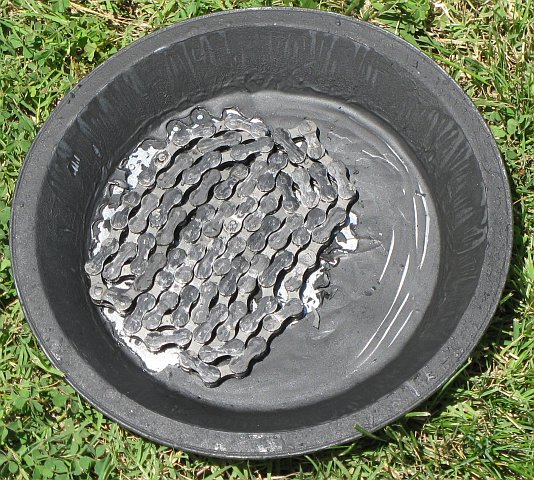
Now I "spray" the graphite at it, which I had put in this smaller container that previously had coarser graphite from the hardware store:
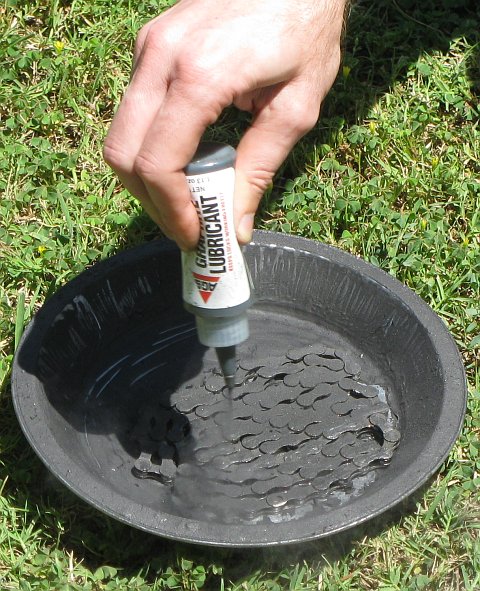
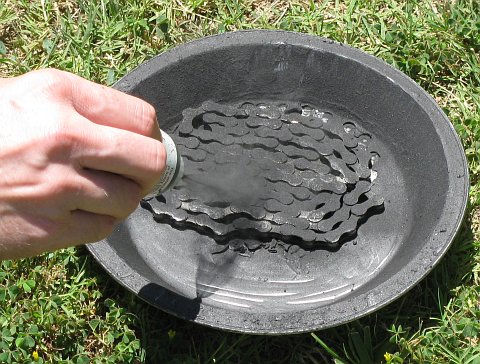
I put enough on that you cannot see the reflection of the sun or other light in the metal through the layer of powder. The tube on the plastic bottle may get clogged up occasionally. Just turn the bottle right side up and let it fall a couple of inches onto a hard surface (sidewalk, garage floor, whatever) and the clog will fall back into the bottle. Then keep going.
completed graphite coat:
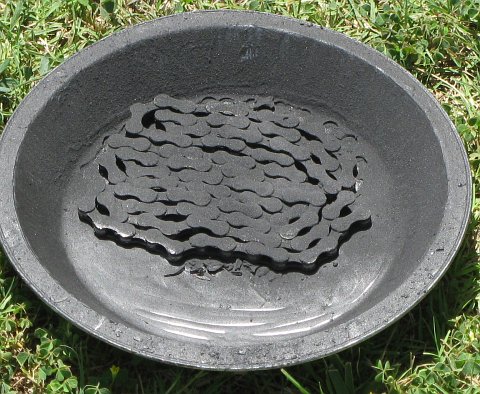
Hmmm... It looks like it could still handle a little more, particularly at the edges.
Now I put it on the stove on the lowest setting, and set the timer for seven minutes. If there's any paraffin on the chain from before, you'll be able to see when it's starting to melt, as the liquid paraffin starts soaking into the top coat of graphite, turning it darker. You can set the votive candle on it (with the wick pulled out of it) and see if it starts to melt. Leave it in one spot only a few seconds. Pick it up and set it down on another part of the chain. As it heats up more, you can start just pushing it around the chain, getting just enough paraffin on the chain to get liquid into the joints and carry the graphite in, but not pooling.
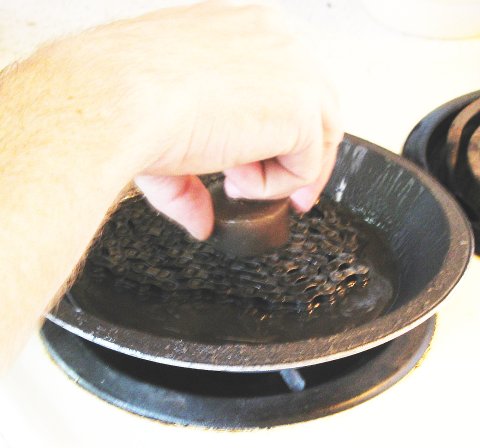
Next, I take a wooden dowel and stir it around to flex all the joints and make sure the stuff gets worked in around all the pins and in the rollers.
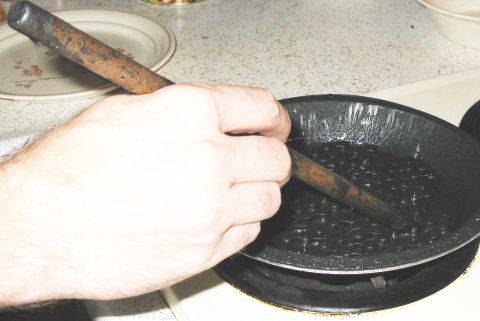
The burner is probably turned off by now. I don't leave it on any longer than the seven minutes I set the timer for. You can experiment and see how much time you need with your stove or hot plate. There is no need to get it up even to the boiling point of water. 160°F is probably enough. I like to keep the SRAM master link together as I'm doing all this (so it's easier to put back on the bike later, for a reason I won't detail right now), but sometimes it comes apart in the stirring, so I use two pairs of tweezers to put it back together before the paraffin cools and hardens. Bunch the chain up and let it sit to harden. Then I press on the bottom of the pie pan and it comes out like this, stiff:
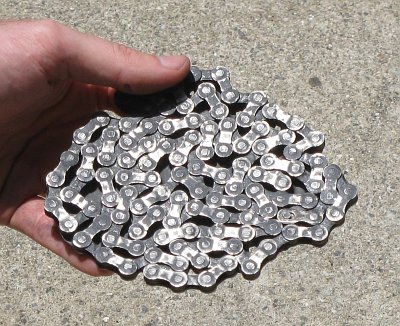
Just stretch it out. Big flakes of paraffin will fall off the outside of the chain, so do it over the pan. You can use those flakes next time, and the job will go faster. Put the chain back on the bike. It will still be kind of stiff, but it will be back to its proper flexibility long before you're warmed up.
There have been times I've gotten all suited up and ready to ride, then realized I had been thinking in the last ride that I really ought to wax the chain again before the next ride but had forgotten to do it, so I do an "express" job. I just put the chain down in the pan on top of the paraffin-and-graphite crumbs that came off the last time, heat it up with the burner set a little higher to melt the paraffin faster but watch it like a hawk, stir it around to just work the stuff back into the parts of the joints again where it's needed, then remove the pan from the stove and take an ice cube and run it around on the underside of the pan to cool it faster, and put the chain back on the bike. The whole project then takes only a few minutes (not more than 10), I grab my water bottles, and go.
I ride hard, and in spite of being 58 years old, it's not more than a couple of times a year that I find someone I can't at least keep up with if not leave behind. I do a lot of climbing on mountain roads, and when I'm in my best shape, I can do out-of-the-saddle climbing for 15 minutes at a time. When not climbing, I normally keep a high cadence (105 is comfortable for a century); but when out of the saddle, I snapped a crank arm four years ago, and have broken a few other parts. This is not to brag, but to stress the significance of the 20,000-mile+ chain life I get with this lube method, when other riders get a few thousand miles max, if not less, even though they use chain cleaners on a religious cleaning schedule. I never clean the chain except when it's brand new, before I ever put it on the bike. This chain in the picture has 8,000 miles on it. You can see it's not grimy.
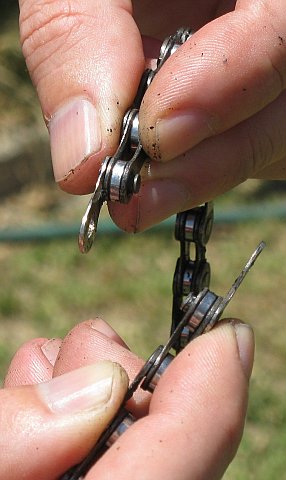
What little unwanted soiling that might be left on my hands can be mostly patted off; and if there's still something left, it quickly comes off with soap and water, effortlessly. The entire drive train stays rather clean by itself. I never get chainring tattoos either.
Shifting performance is extended proportionately as well; so you don't have to be afraid of much of the added life being wasted because of any loss there.
This method may not work well if you ride sometimes in rain. You might have to re-wax too often. I don't ride in rain, but here in SoCal we can go eight months at a time without rain. Even in our rainy season, it comes in storms that may last a few days, and then nothing for a few more or a couple of weeks. In any case, there's no chance of getting caught in a surprise rain. It's quite predictable, just from the forecast.
Posted Oct 29, 2018, last updated Aug 27, 2023 Garth Wilson wilsonmines@dslextreme.com